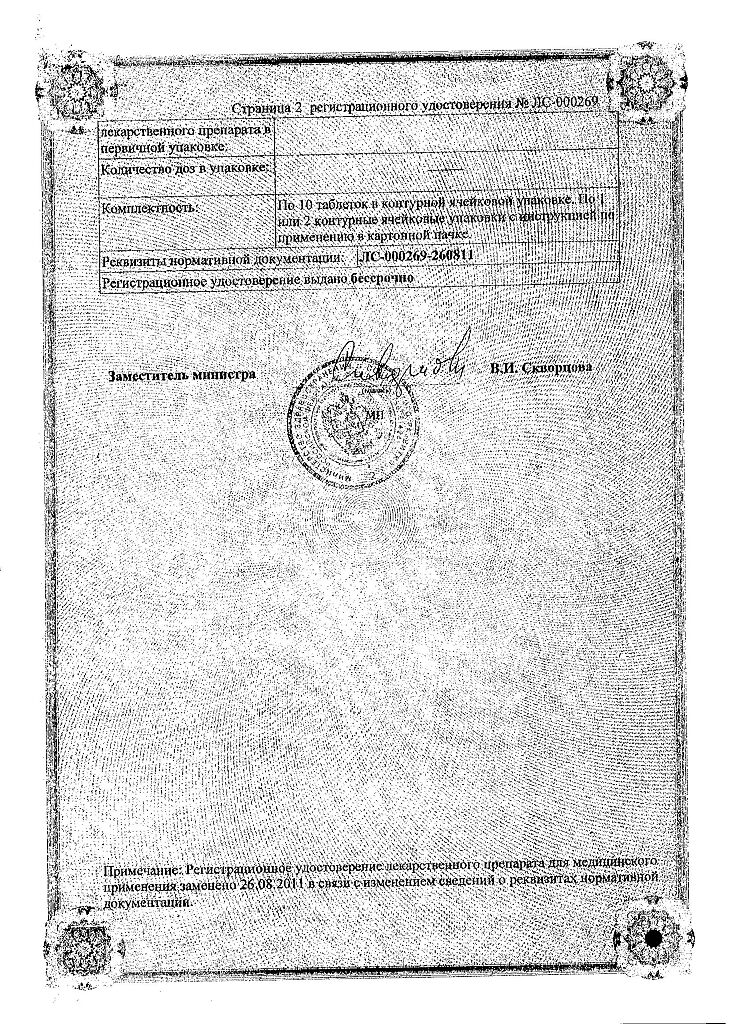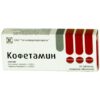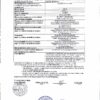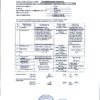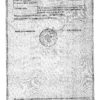No products in the cart.
Cofetamine, 10 pcs.
€11.37 €9.48
Description
Pharmgroup:
Antimigraine agent.
Pharmic action:
Cophetamine is a combination drug.
Caffeine causes stimulation of the CNS, mainly the cerebral cortex, respiratory and vasomotor centers. It increases mental and physical performance, reduces sleepiness and fatigue. It has a marked cardiotonic effect: it increases strength and heart rate, increases BP in hypotension.
Ergotamine causes vasoconstrictor effect. Caffeine accelerates the absorption of ergotamine.
Pharmacokinetics:
After oral administration of Cofetamine, approximately 62% of ergotamine is absorbed in the gastrointestinal tract. Maximum plasma concentrations are reached 2 hours after oral administration. Binding to plasma proteins is 98%.
Ergotamine is metabolized in the liver to form pharmacologically active metabolites. Ergotamine is excreted mainly with bile both unchanged and as metabolites. Excretion is biphasic, with half-lives of 2.7 hours and 21 hours for I and II phases respectively.
Caffeine is absorbed quickly and almost completely after oral administration. Binding to plasma proteins is 35%. Caffeine is almost completely metabolized in the body. Metabolites are excreted mainly with urine.
The elimination half-life is about 3.5 hours.
Indications
Indications
Migraine, arterial hypotension.
Pharmacological effect
Pharmacological effect
Pharmaceutical group:
antimigraine drug.
Pharmaceutical action:
Caffetamine is a combination drug.
Caffeine causes stimulation of the central nervous system, mainly the cerebral cortex, respiratory and vasomotor centers. Increases mental and physical performance, reduces drowsiness and fatigue. It has a pronounced cardiotonic effect: it increases the strength and frequency of heart contractions, increases blood pressure during hypotension.
Ergotamine causes a vasoconstrictor effect. Caffeine accelerates the absorption of ergotamine.
Pharmacokinetics:
After taking caffetamine orally, about 62% of ergotamine is absorbed in the gastrointestinal tract. Maximum plasma concentrations are achieved 2 hours after oral administration. Plasma protein binding – 98%.
Ergotamine is metabolized in the liver to form pharmacologically active metabolites. Ergotamine is excreted primarily in bile, both unchanged and in the form of metabolites. Elimination is biphasic, with half-lives of 2.7 hours and 21 hours for phases I and II, respectively.
After taking the drug orally, caffeine is absorbed quickly and almost completely. Plasma protein binding is 35%. Caffeine is almost completely metabolized in the body. Metabolites are excreted mainly in the urine.
The half-life is approximately 3.5 hours.
Special instructions
Special instructions
Impact on the ability to drive vehicles
During the treatment period, care must be taken when driving vehicles and engaging in other potentially hazardous activities that require concentration and speed of psychomotor reactions.
Active ingredient
Active ingredient
Caffeine, Ergotamine
Composition
Composition
– ergotamine tartrate 1 mg
– caffeine 100 mg
Excipients:
potato starch-0.0238,
talc-0.0031g,
calcium stearate – 0.0006g
Shell excipients;
refined sugar (sucrose) – 0.1346 g,
dextrose monohydrate-0.0207g,
potato starch -0.0647,
talc -0.0072 g,
calcium stearate – 0.0028 g.
Contraindications
Contraindications
Individual intolerance to the components of the drug, children under 12 years of age.
With caution – sleep disorders, anxiety disorders (agoraphobia, panic disorders), organic diseases of the cardiovascular system (including acute myocardial infarction, angina pectoris, severe atherosclerosis, paroxysmal tachycardia, frequent ventricular extrasystoles, arterial hypertension, obliterating diseases of peripheral vessels), liver and/or kidney failure, glaucoma, old age.
Side Effects
Side Effects
From the nervous system: agitation, anxiety, tremor, restlessness, headache, dizziness, convulsions, paresthesia in the extremities, increased reflexes, tachypnea, insomnia; with sudden withdrawal – increased inhibition of the central nervous system, increased fatigue, drowsiness.
From the cardiovascular system: palpitations, tachycardia, cardialgia, increased blood pressure.
From the digestive system: nausea, vomiting, diarrhea.
Allergic reactions: swelling, itching.
Other: with long-term use – addiction, drug dependence, weakness in the legs, myalgia, Leriche syndrome (severe cyanosis, absence of pulse in the lower extremities, pain, distal sensory disturbance).
Interaction
Interaction
Strengthens the pharmacological effect of other drugs containing ergot alkaloids and caffeine.
Caffeine is an adenosine antagonist (larger doses of adenosine may be required).
With the combined use of caffeine and barbiturates, primidone, anticonvulsants (hydantoin derivatives, especially phenytoin), it is possible to enhance metabolism and increase the clearance of caffeine; cimetidine, oral contraceptive drugs, disulfiram, ciprofloxacin, norfloxacin – decreased metabolism of caffeine in the liver (slowing its excretion and increasing its concentration in the blood).
Drugs that cause stimulation of the central nervous system – excessive stimulation of the central nervous system is possible.
Mexiletine reduces caffeine excretion by up to 50%; Nicotine increases the rate of caffeine elimination.
MAO inhibitors, furazolidone, procarbazine and selegiline – large doses of caffeine can cause the development of dangerous cardiac arrhythmias or a pronounced increase in blood pressure.
Caffeine reduces the absorption of Ca2+ drugs in the gastrointestinal tract.
Reduces the effect of narcotic analgesics and sleeping pills; increases – non-narcotic analgesics (increased absorption).
Increases the excretion of Li+ drugs in the urine.
Accelerates absorption and enhances the effect of cardiac glycosides, increasing their toxicity.
The combined use of caffeine with beta-blockers may lead to mutual suppression of therapeutic effects; with adrenergic bronchodilators – to additional stimulation of the central nervous system and other additive toxic effects.
Caffeine may decrease the clearance of theophylline and possibly other xanthines, increasing the potential for additive pharmacodynamic and toxic effects.
The vasoconstrictor effect of the drug is enhanced by alpha-adrenergic stimulants, beta-blockers, serotonin agonists (including sumatriptan) and nicotine. Macrolides increase the toxicity of ergotamine (decreased hepatic clearance of caffeine).
Overdose
Overdose
Symptoms: increased severity of side effects, including nausea, vomiting, numbness of fingers and toes, lethargy, drowsiness, epileptic seizures, stupor, coma.
Treatment: gastric lavage, intake of activated carbon, and, if necessary, symptomatic therapy.
Storage conditions
Storage conditions
In a dry place, protected from light, at a temperature not exceeding 25 °C
Shelf life
Shelf life
2 years
Manufacturer
Manufacturer
Tatchimpharmpreparaty, Russia
Additional information
| Shelf life | 2 years |
|---|---|
| Conditions of storage | In a dry, light-protected place at a temperature not exceeding 25 °C |
| Manufacturer | Tatkhimpharmpreparaty, Russia |
| Medication form | pills |
| Brand | Tatkhimpharmpreparaty |
Related products
Buy Cofetamine, 10 pcs. with delivery to USA, UK, Europe and over 120 other countries.




